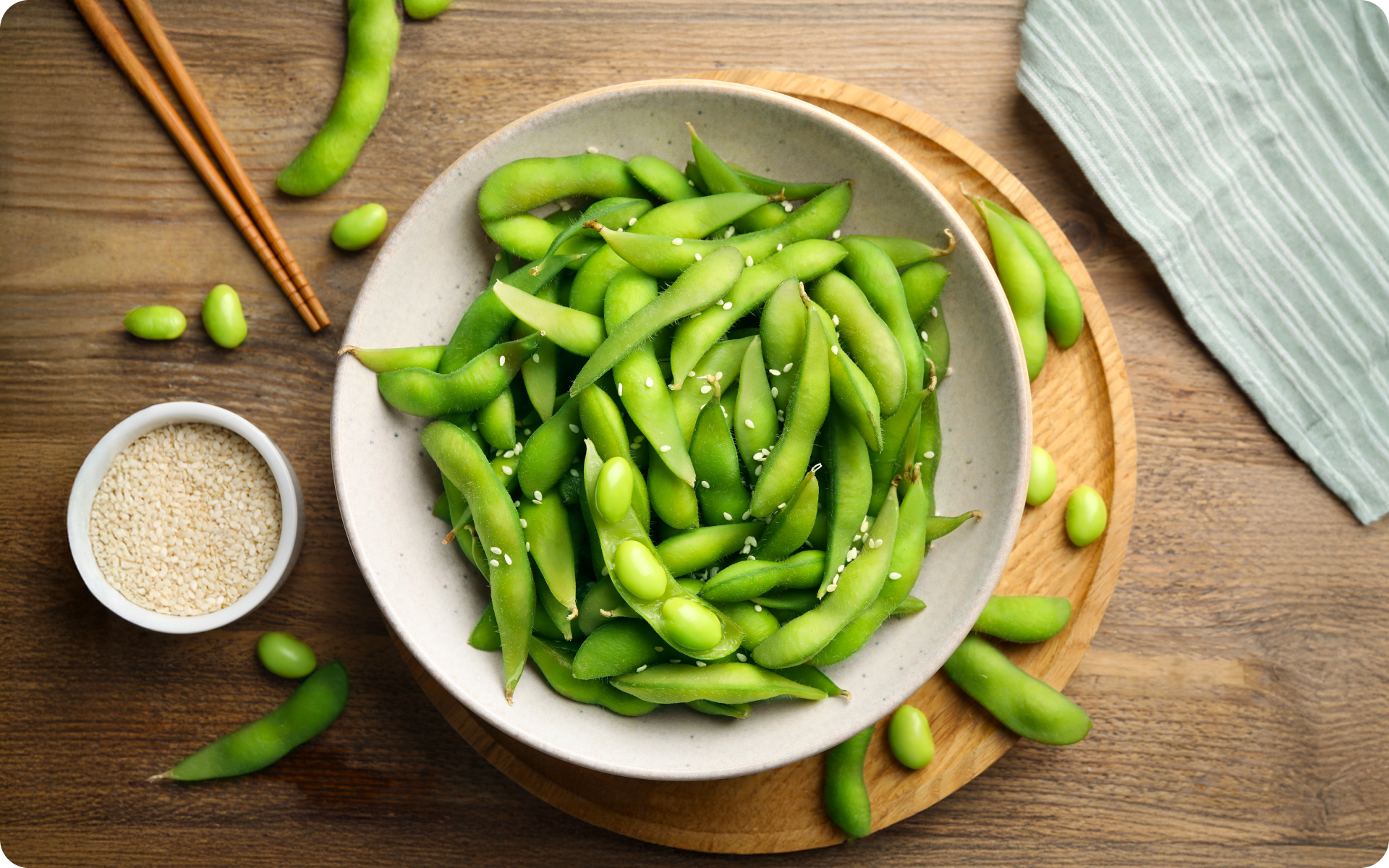Edamame is a popular type of soybean dish that can be eaten as a snack or used as an ingredient in many dishes. The soybean originated from China and was later introduced to Japan, where it became a part of the regular diet.
Edamame contains high levels of protein, fiber, and several vitamins and minerals. It also contains all nine essential amino acids, making it a nutritional powerhouse.
Unfortunately, there are some side effects that are associated with eating too much edamame. In this article, we’ll discuss the many health benefits of this vegetable, in addition to its potential side effects.
What Is Edamame?
Edamame are young, green soybeans, typically harvested before they mature. They’re rich in nutrients such as fiber, protein, vitamins, and minerals. Edamame contains isoflavones, which are plant compounds that resemble human estrogen.
Some research has suggested that these isoflavones may have minor estrogenic effects, which could potentially impact weight loss by influencing factors such as metabolism and appetite.
However, the evidence of edamame for weight loss is not definitive. Still, incorporating edamame into a balanced diet can offer health benefits due to its nutrient content and potential satiating effect, which may indirectly support weight management goals.
If you tend to let yourself off the hook, raise the white flag when things get tougher than you expected, send yourself on an unconscious binge-eating trip – BetterMe app is here to help you leave all of these sabotaging habits in the past!
What Are Edamame Side Effects?
Although there are many benefits to eating edamame, it can also cause some unpleasant side effects.
Possible Allergies
Soy is a common food allergen. Allergic reactions in people who are sensitive to them can range from mild itching and hives to life-threatening anaphylaxis (14). If you have other food allergies, your doctor may want to test you for soy allergy too.
Might Contribute to Hypothyroidism
There is concern that edamame may cause or worsen hypothyroidism as soy contains goitrogens, which can hypothetically interfere with the proper functioning of your thyroid gland. However, studies have not found soy to have any significant effect on thyroid function in healthy people, and even those with compromised thyroid function don’t need to avoid soy products as long as they also get enough iodine (8).
Diarrhea
One possible edamame side effect is diarrhea. As this vegetable contains fiber that helps with bowel movements, if you eat too much of it, an excess amount of fiber could result in some loose stools, particularly if you’re not used to eating much fiber. If you want to increase your fiber intake, it’s best to do it gradually and make sure you also drink plenty of fluids (14).
High Intake of Phytoestrogens
Soy contains phytoestrogens, molecules that are similar to the human hormone estrogen to bind to its receptor sites on cells in the body. In some cases, this results in weak estrogen-like activity, while in other cases, it prevents actual estrogen from binding and therefore inhibits its effects. (15). For most people, consuming soy in moderate amounts is completely safe and won’t cause any adverse effects.
Edamame Side Effects: Is It Safe to Eat?
Edamame is incredibly safe to eat. If you’re concerned about a potential allergy or how phytoestrogens may affect you, you should discuss your concerns with your healthcare provider. However, moderate soy intake generally doesn’t pose significant risks and is considered to be safe and potentially beneficial for most people.
What Are Edamame Beans Good for?
Despite having a few potential side effects, edamame is a healthy vegetable that contains high levels of nutrients. When consumed in moderation, it can be quite beneficial. Eating a serving of this vegetable provides the following health benefits:
High in Fiber
Due to its high fiber content, edamame can help treat constipation and improve bowel movements. Fibers also help with weight loss and lowering cholesterol. If you’re suffering from diabetes, the fiber in edamame may help lower your blood sugar levels (9).
High in Protein
A cup (155 grams) of cooked edamame provides approximately 18.5 grams of protein, which is approximately 34% of the recommended daily intake for adults (4). The high protein content is incredibly important for pregnant women as it helps with fetal development. Proteins also play a vital role in muscle growth and repair.
High in Vitamins
One serving of edamame contains a decent percentage of your daily vitamin E, magnesium, folate, and manganese intake. Vitamin E is an antioxidant that helps prevent cardiovascular disease while folate prevents neural tube deformities during fetal development (18). Magnesium helps with the release of energy in your body, while manganese is used for bone formation and collagen synthesis (11).
Low in Saturated Fat
Saturated fats are not good for your heart health as they contribute to increasing LDL cholesterol (bad cholesterol) levels. Edamame contains almost no saturated fat, so it can help protect you from the development of cardiovascular diseases (17).
High in Iron
Edamame is high in iron, which is essential for red blood cell production. Eating this vegetable can help prevent conditions that result from low iron levels, such as anemia (3).
Read more: 7-Day Weight Loss Low-Carb Diet: Choose High-Protein, High-Fiber, or Ultra-Low-Carb
High in Omega-6 Fatty Acids
Omega-6 fatty acids are essential nutrients for your body. While an excessive amount of omega-6 in your diet has been linked to increased inflammation, eating edamame is unlikely to lead to such an imbalance. In addition, polyunsaturated fats in general can help improve blood lipid levels, particularly when they replace saturated fats in your diet (10).
May Reduce the Risk of Some Types of Breast Cancer
Due to its phytoestrogen content, edamame may help inhibit the growth of certain types of cancerous cells in your breasts. Research has also shown that it may prevent the metastasis of breast cancer by exerting anti-estrogenic activity. However, the effects of soy isoflavones on the body are complicated, and more long-term controlled studies are required to prove these claims (17).
May Reduce the Risk of Prostate Cancer
Approximately one in seven men will get prostate cancer at some point in their lives. Men with diets that are high in soy products, such as cooked edamame, may have a lower risk of developing this type of cancer. However, there is not enough current evidence to show that eating edamame can prevent prostate cancer.
Several observational studies have indicated that a diet high in soy products, including edamame, is associated with a lower risk of prostate cancer. More research is needed in order to confirm the link between edamame and prostate cancer (17).
May Reduce Osteoporosis Risk
Research has suggested that women who eat more soy foods tend to have improved markers of bone health than those who rarely consume them. This may be due to its isoflavones and calcium content (16).
May Help Prevent Diabetes
The high levels of fiber and protein that are found in edamame can help lower blood sugar levels if you already suffer from diabetes. Fiber also helps slow the absorption of sugars by slowing down digestion, which prevents sharp blood sugar spikes (9).
May Reduce Menopausal Symptoms
Edamame is high in phytoestrogens, which may help with conditions that occur during menopause such as hot flashes and mood swings (17). However, data is conflicting on whether soy phytoestrogens exert enough estrogen-like activity to have a meaningful effect on these symptoms
Recommendations for Eating Edamame
Although you can eat edamame as an appetizer, side dish, or snack, it’s best to consume it together with other foods as part of a balanced meal. For example, you can have it with fish and brown rice or stir-fried with chicken and vegetables.
If you want to eat edamame as a snack, the serving size is approximately a half cup shelled (or just over 1 cup in the pods).
In order to get the most nutrients and minerals from this vegetable, it’s recommended that you steam it for three to five minutes. Steaming will prevent the loss of important vitamins and minerals while retaining all of its other healthy components, such as proteins and omega-6 fatty acids.
Where to Buy Edamame
Although edamame is widely available in supermarkets, try looking in your local Japanese or Korean grocery stores for a wider selection of fresh edamame as they may be cheaper there. Frozen types are also available throughout the year, so you won’t miss out on the health benefits even when these vegetables are not in season.
BetterMe app is a foolproof way to go from zero to a weight loss hero in a safe and sustainable way! What are you waiting for? Start transforming your body now!
Edamame Recipes and Meal Ideas
Here are some top edamame recipes you can try at home:
Edamame Hummus (6)
Whether you’re looking for an appetizer or a snack, this simple recipe served with crackers or pita bread delivers a delicious combo that will have you coming back for more. Here’s how you make it:
Ingredients
- ½ cup tahini
- ⅓ cup lemon juice ( 2 to 3 lemons)
- 3 tablespoons extra-virgin olive oil, plus more for garnish
- 1 medium clove garlic, roughly chopped
- ½ teaspoon fine-grain sea salt
- ½ cup lightly packed fresh cilantro leaves, plus more for garnish
- 1 ½ cups shelled edamame (10 ounces), preferably organic, defrosted if frozen
- 2 to 4 tablespoons water, as necessary
- Sesame seeds for garnish (optional)
Instructions
- Combine the lemon juice, tahini, olive oil, garlic, and salt in the bowl of a food processor or high-powered blender.
- Process the mixture for approximately 1 ½ minutes until it is well blended, only stopping to scrape down the base and sides of the bowl as required.
- Add the cilantro and continue pressing for approximately 1 minute until all the herbs are well blended in the mixture and it turns smooth. Stop to scrape down the bowl as needed.
- Place half the edamame in the food processor plus 2 tablespoons of water and process for approximately 1 minute. After scraping down the bowl, add the remaining edamame and continue processing for 1 to 2 more minutes until the hummus is thick and smooth.
- Taste then blend in additional salt if the hummus has not yet reached the desired taste.
- Scrape the hummus into a small serving bowl and lightly drizzle the olive oil over the top.
- Finally, sprinkle over a few sesame seeds and some additional cilantro leaves if desired.
Edamame Quinoa Salad (7)
This is a light, healthy, and simple meal that is packed with lots of superfoods. Here’s how you make it:
Ingredients
- 2 cups uncooked quinoa
- 4 cups water
- ½ teaspoon salt
- 1 cup celery, sliced
- 1 (15 oz) can corn, drained
- 1 (15 oz) garbanzo beans, rinsed and drained
- ¾ cup cilantro, finely minced
- 1 heaped cup dried cranberries
- 1 (12 oz package) edamame, cooked and shelled
- 2 red bell peppers, diced
- 1 cup sliced almonds
- 3 tablespoons olive oil
- 5 tablespoons lime juice
- Salt to taste
Instructions
- Start by adding the water, quinoa, and salt to a medium saucepan and bring it to the boil.
- Once boiled, turn down the heat to low, cover it, and allow it to cook for 15-20 minutes or until done. Remove and transfer to a large bowl then fluff it using a fork.
- Add the remaining ingredients and toss until they are well combined. Add salt to taste and serve.
Edamame and Pea Bruschetta Recipe (5)
For the best experience, spread this onto toasted bread or thin it out using hot pasta water and use it as a pasta sauce. Here’s how you make it:
Ingredients
- 1 cup frozen shelled edamame (soybean)
- ½ cup frozen peas
- 1 garlic clove, minced
- 2 scallions, chopped
- ¼ cup packed basil leaves
- ¼ cup extra-virgin olive oil
- ¼ cup grated parmesan cheese
- Salt and fresh ground black pepper
- Baguette, cut into slices and toasted
Instructions
- Pour water into a medium saucepan and bring it to the boil.
- Add ½ tablespoon salt and the edamame to the water and cook it for 4 minutes before adding the peas. Cook for an extra minute.
- Put some fresh ice water in a separate large bowl that will be used to cool the peas and edamame once they’re cooked.
- Transfer the peas and edamame to the ice bath using a slotted spoon. Allow it to cool, then drain it and set aside.
- Pulse the scallions and garlic a few times in a food processor. Add the basil leaves, peas, and edamame and pulse an extra 3-4 times until the mixture is chopped into very small pieces.
- Allow the processor to continue running and carefully stream the olive oil over the mixture until everything is well combined. At this point, it should have the appearance of a thick pesto.
- Remove and transfer to a bowl and stir in the cheese, freshly ground pepper, and a pinch of salt.
- Toast slices of the baguette using a griddle or oven and smear one tablespoon onto each slice before serving.
Read more: 24 Weight Loss Smoothies, 2 Diet Plans, and 5 Belly Fat Smoothie Secrets
FAQs
Is edamame difficult to digest?
As edamame are young soybeans, they have a high dietary fiber content, which may cause moderate digestive difficulties for some people. Although it’s necessary for healthy digestion, fiber can be uncomfortable for those who aren’t used to eating a lot of it. However, due to its soft texture and younger age, edamame is generally easier to digest than mature soybeans. (1)
Edamame’s high fiber content can help promote regular bowel motions and feelings of fullness. (2) However, eating too much edamame can cause gas, bloating, or other moderate digestive discomfort in those who are sensitive to high-fiber meals.
Any potential digestive problems can be minimized by combining edamame with other foods that are easy to digest and by introducing it gradually into your diet. When edamame is cooked, some people may find it easier to digest than when it’s raw. Examples of these techniques include steaming or boiling.
Although some people may experience moderate digestive difficulties when they eat edamame, it’s a filling and healthy snack or side dish for the majority of people that provides a variety of nutrients such as fiber, protein, vitamins, and minerals. To get the benefits of its health without experiencing any discomfort, ingestion should be guided by moderation and individual tolerance.
Is edamame good for your stomach?
Yes, edamame can be beneficial for your stomach health. (1) It contains dietary fiber, which supports digestive health by promoting regular bowel movements and preventing constipation. The fiber in edamame can also help maintain a healthy balance of gut bacteria, which supports overall digestive function.
Furthermore, edamame is a plant-based protein source that may be more palatable to the stomach than certain animal-based proteins. Many people find it to be generally well-tolerated, and it offers a nutrient-rich, low-saturated-fat and cholesterol choice that may help improve the general health of your stomach.
Individual tolerance differs and those who aren’t accustomed to eating a lot of fiber may experience slight pain in their digestive tract. Edamame can help your stomach adjust and potentially benefit from its nutritional content for digestive wellness if it’s used moderately and gradually in your diet.
Does edamame mess with estrogen?
Edamame contains compounds called isoflavones, which are phytoestrogens—plant-derived compounds that have a structure similar to human estrogen. These isoflavones can weakly mimic the activity of estrogen in the body. Some research has suggested that consuming foods that are rich in isoflavones, such as edamame, may have minor effects on estrogen levels in the body, although the impact is generally considered to be subtle and not well-understood. (13)
Moderate edamame consumption as part of a balanced diet is unlikely to significantly disturb estrogen levels or have any negative effects for most people. However, before you make any major dietary changes, including increasing the intake of foods that contain phytoestrogens such as edamame, it is advised that you speak with a healthcare provider if you have specific concerns about estrogen levels or conditions related to hormones.
Do edamame beans contain toxins?
As with many legumes and plants, edamame beans are composed of naturally occurring substances called lectins and phytates, which are referred to as “antinutrients”. These substances are a component of the plant’s defense mechanism and may cause stomach pain in some people or obstruct their absorption of specific nutrients. (12)
Lectins in particular may pose digestive problems, and they are present in higher concentrations in raw or undercooked legumes such as edamame. However, lectin levels are dramatically lowered by cooking techniques such as boiling, steaming, or blanching, which makes edamame safer and easier to digest.
Furthermore, moderate intake of cooked edamame is regarded as safe and healthful for most people, while some may be sensitive to lectins or phytates. (2) When they’re incorporated into a balanced diet, these beans provide several health advantages, in addition to being a healthy source of fiber, vitamins, minerals, and plant-based protein.
Generally, when edamame is prepared correctly, the risks related to lectins and phytates are reduced, which makes enjoying the nutritious benefits of edamame without having to worry too much about toxins possible.
The Bottom Line
Although edamame has several potential side effects when it is consumed in large quantities, the benefits it provides far outweigh them. Eating this vegetable can help protect your heart and prevent several common diseases that occur as you age. It is also an excellent source of protein, vitamins, and minerals, so it can be a great addition to your diet.
DISCLAIMER:
This article is intended for general informational purposes only and does not serve to address individual circumstances. It is not a substitute for professional advice or help and should not be relied on for making any kind of decision-making. Any action taken as a direct or indirect result of the information in this article is entirely at your own risk and is your sole responsibility.
BetterMe, its content staff, and its medical advisors accept no responsibility for inaccuracies, errors, misstatements, inconsistencies, or omissions and specifically disclaim any liability, loss or risk, personal, professional or otherwise, which may be incurred as a consequence, directly or indirectly, of the use and/or application of any content.
You should always seek the advice of your physician or other qualified health provider with any questions you may have regarding a medical condition or your specific situation. Never disregard professional medical advice or delay seeking it because of BetterMe content. If you suspect or think you may have a medical emergency, call your doctor.
SOURCES:
- Are Edamame Healthy? (2023, verywellhealth.com)
- 8 Surprising Health Benefits of Edamame (healthline.com)
- Eat Smart to Prevent Iron Deficiency (2019, fhs.gov.hk)
- Edamame, cooked (2020, usda.gov)
- Edamame and Pea Bruschetta Recipe (n.d., inspiredtaste.net)
- Edamame Hummus (n.d., cookieandkate.com)
- Edamame Quinoa Salad (2014, the-girl-who-ate-everything.com)
- Effects of soy protein and soybean isoflavones on thyroid function in healthy adults and hypothyoid patients: a review of the relevant literature (2006, pubmed.gov)
- Health benefits of dietary fiber (2009, pubmed.gov)
- Health Implications of High Dietary Omega-6 Polyunsaturated Fatty Acids (2012, nih.gov)
- Magnesium (2021, nih.gov)
- Oxalate and phytate of soy foods (2005, pubmed.gov)
- Reproductive consequences of Developmental Phytoestrogen Exposure (2012, nih.gov)
- Soy Allergy: Symptoms, Treatment & Tests (n.d., clevelandclinic.org)
- Soy and Health Update: Evaluation of the Clinical and Epidemiologic Literature (2016, nih.gov)
- Soy foods: are they useful for optimal bone health (2011, nih.gov)
- Straight Talk About Soy (n.d., harvard.edu)
- Vitamin E (2021, nih.gov)











